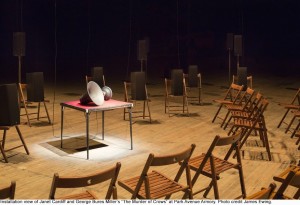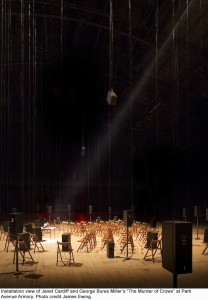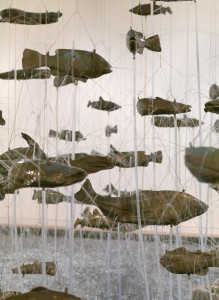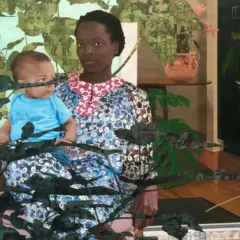Steve and I ran up to New York Aug 23/24 to catch the last gasp of summer. In addition to all the tourists we saw, we were lucky enough to catch the Janet Cardiff/George Bures Miller The Murder of Crows, Bruce Nauman’s Hundred Fish Fountain and the Rineke Dijkstra retrospective at the Guggenheim. Here’s a report.
Crows in the Armory
Janet Cardiff and George Buress Miller’s A Murder of Crows at New York’s Park Avenue Armory has been compared to ghost stories told around the camp fire. That analogy holds up pretty well for the recently closed audio immersion. It delivered a good punch if not a punchline.
I saw the piece with Steve and Cate, and as we sat on wooden folding chairs arranged in front of a card table with a gramophone plunked on it like a beached whale, we felt a little like acolytes gathered for a meeting of some secret society.
The space — the Armory’s huge Drill Hall — was bathed in darkness but for the spotlit center, very theatrical, very effective in focusing you on the sounds.
The sounds — human and animal, loud and quiet, natural and unnatural — came from the 98 speakers and 21 amplifiers set up in the space around the audience. The sounds were programmed to move around the space from speaker to speaker and because of that movement, the piece did feel as if ghosts were swirling around you, certainly their sounds were.
Emanating from the gramophone came the stories, told by Cardiff, narrating three dreams she had. If you’ve ever tried to tell someone your dreams, or had someone tell you one of theirs, you will understand that this is the central problem of the piece. Retelling your dreams is like telling a joke that doesn’t have a punchline — the story falls a little flat.
That said, Cardiff’s voice and deadpan recounting of her dreams is great. As with famous “walks,” you have a seductive narrator telling you things you wouldn’t otherwise hear. But unlike with her walks, which do have story arcs of a sort, these three short dreams — which like all dreams are inscrutable — have at their base the fact that you the listener were not there and cannot “feel” the dream’s core eeriness or fright or whatever emotion was felt by the dreamer. The distance between what Cardiff experienced while asleep and what you heard, while awake, is too large.
[Quickly, here are the stories:
–House on a beach that she forgot she owned. Upstairs someone is in the bed, a leg sticking out. The leg is not attached to a body. She feels something terrible will happen.
–Factory with blood everywhere. Cats and babies are fed into machines…it’s all very organized and systematic. She feels she is trying to get away.
–In a jungle in a car. People chained up are walking on the road. They look like slaves. A kid says please help me and threatens to cut off his leg.]
Perhaps the piece is too specific and concrete with its imagery — or maybe it has just too much imagery — to convey the true essence of a slippery dream state. Dreams are hard. The artists who really dealt well with dreams were the Surrealists. Dali with his melting watches, DeChirico with his depopulated piazzas — those were imagists, who knew how to deliver the eeriness of dreams through universal symbols that didn’t tie them down to a story.
Goya’s The Sleep of Reason Produces Monsters from Los Caprichos 1799 is the artists’ reference point. That image, which shows a sleeping man surrounded by a flock of owls, bats and cats, is Goya’s response to the horrors of human folly all around him. Cardiff and Miller have produced not the audio equivalent of Goya’s iconic work, but an iconic work whose sensibility is more gothic and macabre than tragic and horrible. Maybe it’s the proper response to our times — which are pretty gothic and macabre in many ways.
I did not dislike this piece, although I was unhappy with the dream stories, which, unlike ghost stories, didn’t have a narrative arc to follow and drifted off into nothingness, no punchline, no moral, no resolution.
The stories trigger the sounds — of seagulls, crows, ocean waves; clanging factory noises; marching feet, a band, an orchestra with chorus — but ironically they were not able to stand up to the rich orchestration of sound that took off from their words and embroidered, tweaked and enhanced.
I want to compare the experience of sitting through the 30-minute piece to a concert, with three discrete pieces of music on the playlist. In fact, the printout we picked up at the Armory titled the stories “Libretto,” as in, words for the music.
The term murder of crows, by the way, refers to a a flock of crows and to the flock’s unusual ability to mourn the loss of one of its members. The piece The Murder of Crows was originally commissioned for the Biennale of Sydney in 2008. It was also shown in Berlin, and the installation at the Armory was its largest iteration. The work showed under the auspices of the Park Avenue Armory and the Mostly Mozart Festival.
Fish in the Fountain
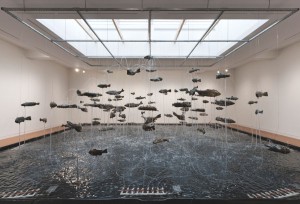
We also stopped by Gagosian’s uptown gallery (980 Madison Ave.) to see Bruce Nauman’s One Hundred Fish Fountain (closed Aug. 31), an audio-visual work whose atmospherics, unlike with The Murder of Crows, are not in the realm of magic and dreams.
Nauman, who is known for his highly conceptual work and often exposed infrastructures that celebrate the tubes, electricity and mechanics that make the world go round, has created a waterworks that includes a black rubber cachement basin, maybe 6 inches deep, that holds the pipes and water that run through the fish. It’s quite inelegant, but works great.
Each of the hundred bronze-cast fish, is suspended above the shallow basin, and spigotted by a clear plastic tube that brings water up and into the fish, from whence it pours out through holes in the mouth, eyes, and gills.
The fountain turns on and off in 15-minute cycles. When the piece is at rest it truly looks forlorn, the fish, which are cast from fish caught by the artist and his late dealer Donald Young, are insensate and inelegant as any fountain creature when the water is off.
Maybe the best part of the piece is that it takes up almost the entire room in the gallery and you are forced to walk around it hugging the walls. When the fountain is on, it sends off a cool spray of mist that was most refreshing. Check out the video.
A minor piece by a major guy, who, by the way, likes to fish – a lot.
Teens at the Guggenheim
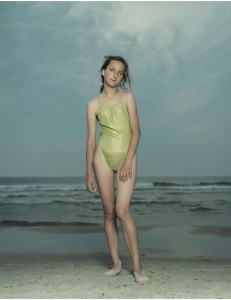
Rineke Dykstra’s retrospective at the Guggenheim (up to Oct. 3) sprawls over four floors of the museum. It’s a fantastic trove of 71 people-pictures and 5 video installations – made by an artist with a lot of empathy. Dykstra gets people to expose themselves emotionally in her large-format works. And in these intimate pieces she captures an incredible amount of vulnerability.
While Dykstra has worked with several people over time, photographing, in one case, a refugee from early girlhood through her evolution into motherhood, the work I love best deals with individual teens and young adults — strangers to the artist — who display for the camera both their awkwardness in their own skin and their beauty.
The artist’s recent works in video, are a great counterpoint to the somber-faced still portraits. In these cases, the artist goes to dance clubs and sets up her equipment. At Krazyhouse in Liverpool, she videod the young adults dancing to music and after a few awkward seconds, you see a magic transformation — as they settle in to the music, they become someone else, someone without an awkward bone in their bodies.
Without meaning to, I believe Dykstra caught a young Polish girl in 1992, whose pose echoes (in reverse) and completely naturally, the pose of Botticelli’s Venus. I have never thought of Venus as a poignant work (it isn’t), but Dykstra’s Venus is achingly beautiful and poignant.


